23. Knockdown is a myth
Not long ago I met on safari a fellow toting a rifle in .416 Weatherby Magnum. It is a truly potent cartridge, its 400-grain bullets pummeling targets with 6,400 ft-lbs of energy. The ferocious recoil can be throttled back to merely unpleasant by a muzzle brake, if you can brook the land-mine concussion. “Nice rifle,” I said, admiring the Mark V’s lovely walnut. A couple of days later, this fellow had to follow blue wildebeest he had crippled with that .416. Raw power, it seems, is no substitute for precise shooting.
In Sweden, where thousands of moose are shot each year, sportsmen favor the old 6.5x55 cartridge over more potent rounds. The .30-06 is next in popularity, then the .308 Winchester. As a hunting guide, I’ve watched hunters tip over elk with lightweight bullets from .270-class rifles. I’ve also seen elk run after being hammered repeatedly with bullets that dumped frightful doses of energy. The key to sure kills: bullet placement. Only when you’ve learned to shoot accurately can you get tangible benefits from turbo-charged bullets that fly flatter than the curve of the earth and deliver a ton of smash in the next time zone.
The notion that your bullet must carry a certain level of kinetic energy to kill big game is widely accepted because it makes sense. In truth, it is flawed. I have it on good report that a couple of fellows, on a dare, once killed an elephant with a .22 rimfire. They downed this huge beast by swatting it with less than 140 ft-lbs of energy. Most assuredly a stunt, it points up the absurdity of measuring lethality in foot-pounds.
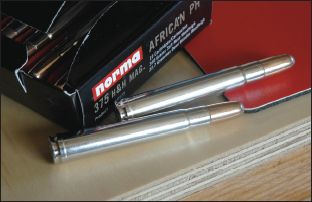
Norma’s Africa PH series features tough bullets for tough game, like the .300-grain Woodleigh softpoints in .375.

Dale Gardner made an excellent shot with his Kimber in 7mm-08 to down this magnificent kudu.
The counter argument is that most sportsmen want to take advantage of the first reasonable shot opportunity. They might concede that a pellet from a frisky air gun would kill a deer shot through the ear at spitwad range. But who courts that limitation? If we see a buck climbing the next ridge, we expect the rifle in our hands to down it quickly with a shot to the front ribs.
When you can’t insert a bullet like a needle in a vein, you need extra energy to knock an animal down. At least, that’s the common conclusion. It’s only partly valid. More energy does result in more tissue damage, which can hasten or ensure death. On the other hand, a more powerful blow does not necessarily mean the animal will fall down right away. That’s because animals are rarely knocked down by bullets. A bullet, after all, is not an automobile or a locomotive, both of which knock animals down regularly. Even a big bullet is tiny, compared to the animal. Its lethality depends in large measure on its speed. For example, a centerfire rifle bullet moving 2,000 fps is now considered sluggish. A bullet striking a deer at less than 1,400 fps may not even upset properly. In comparison, a sedan traveling at 88 fps (60 mph) not only kills a deer instantly upon collision, but throws it, inflicting terrific internal damage and perhaps dismembering it.
Dangerous animals must not only be killed but stopped. Hunters in Africa rely on cartridges like the .458 Winchester Magnum to drop game as big as elephants right away. I’ve seen elephants struck by .458 bullets collapse as if struck by lightning. The .458 sends about 5,000 ft-lbs of energy out the muzzle—2 ½ tons of knock-down punch, say some. But the bullet energy-to-animal weight ratio of a .458 to an elephant is about the same as that of a .22 Long Rifle to a big whitetail deer. If a .458 can be counted on to stop an elephant, why doesn’t the .22 deck big deer?

In Africa, reliability counts as much as accuracy, power. This PH favors a CZ rifle in .416 Rigby.
I’ll recount here a clever experiment one fellow devised to test knock-down power. He fashioned handles for a thick steel plate so he could support it in front of him on the edge of a table. Then, from close range, a friend fired into the plate with a 500-grain softnose from a .458. The bullet spent its 2-½ tons of kinetic energy on the plate without knocking the man down! Caution! Despite previous firings to ensure that the bullet would not penetrate the steel, this exercise entailed some risk; firing a bullet toward another person is never a safe practice and cannot be recommended! Firearms etiquette aside, the results of this exercise are insightful. They suggest there’s no such thing as knockdown power in bullets. Animals fall down when they are fatally stricken—either weakened by blood loss or denied the function of a vital organ. A bullet can appear to slap the animal to earth when it hits a supporting bone or destroys nerves that control the legs. A bullet doesn’t kill deer in the woods the way a dump truck kills deer on the highway.
The reaction of game to a bullet, like the lethality of a hit, depends on bullet placement as well as on the energy package. It also depends on what the bullet does. Hiking energy increases the likelihood of a quick kill only if the bullet can translate that energy into the destruction of vital organs. More power can mean deeper penetration (a longer wound channel) or more violent expansion (a wider wound channel) or both. You may get more value from one than from the other.
The notion that very fast bullets kill quicker has some merit. High velocity means more violent bullet expansion, all else equal. Quick energy release can be instantly lethal. The results of explosive bullet action on small animals are often used to argue the case for high-speed. But there is no shoulder-fired rifle that can kill deer in the manner that a .22-250 unhinges prairie dogs.

The powerful .450 Alaskan, a wildcat on the .348 Winchester, was once popular in the Model 71.

L-R: .338 Winchester, .338 Ultra Mag, .340 Weatherby. All deliver over 4,000 ft-lbs of energy.
Deer and other big game animals commonly survive some seconds or minutes after a well-placed and lethal shot from a powerful cartridge. Once, I fired at a whitetail that slipped into view 80 yards away. I called a good hit in the forward ribs. But the buck ran off as if not hurt at all. I eased over to where the deer had stood and found nothing but a faint scuff-mark in the forest floor. No blood. No hair. Carefully I circled the mark. Eventually I found a bit of lung tissue the size of a BB. Tracks put me on an exit trail. On the third try I caught the buck’s right-angle turn and found blood. Shortly, I came upon my prize, dead. The 150-grain .300 Savage bullet had penetrated both lungs. The buck had died in mid-stride only seconds after the hit. Would it have been a quicker kill with a faster bullet? That’s hard to say. Explosive bullet action can drop an animal that might stagger off or run when hit in the same place by a slower or less frangible bullet. But the outcome is the same: an animal soon dead. Explosive rupture works against you when the animal is big and quartering and you must have a deep-penetrating bullet to reach the vitals.
I borrowed a .30-30 rifle once to hunt blacktail deer. As luck would have it, I spied a dandy four-point as it bounced from a blackberry thicket only 30 yards off. I led him too much at first, then corrected and hit his shoulder. The last of my four shots caught him in the rear ribs as he cleared a deadfall going away. He lay dead perhaps 40 yards beyond. A more powerful round, especially one firing a fast-opening bullet, might have put the skids under that buck with the first hit. The second might have sent him into a somersault. But those pokey .30-30 bullets were still lethal.
I think the allure of super-potent cartridges has to do, at least in part, with the perverse notion that recoil tests manliness. That is, if you shoot a big cartridge, you’re more of a male than someone who shoots a small cartridge. As Jack O’Connor might have said, this is the purest of applesauce. You can set a very powerful rifle against a sack of rolled oats and shoot it comfortably all day long. What does this say about rolled oats? Shooting is not about absorbing recoil; it’s about hitting a target. There are legitimate reasons for buying rifles in magnum chamberings. But you might do some math before selling that ‘06.
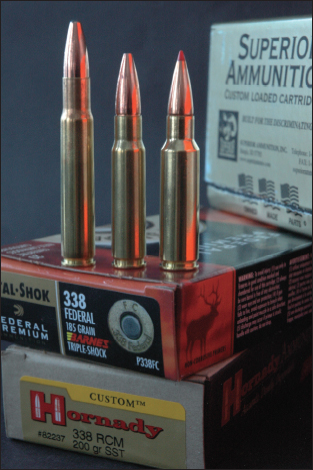
L-R: .338-06 A-Square, .338 Federal, .338 RCM. Great alternatives to heavy-bullet .30-06 loads.

Phil Quick approaches a deer after it fell to a long shot from a GreyBull rifle in 7mm Rem. Mag.
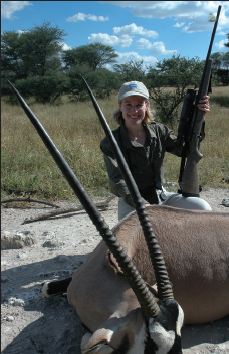
Gemsbok are notoriously tough, but Shannon Jackson got his bull with one well-placed shot.

Wayne killed this Namibian gemsbok with a Sako rifle in .30-06. Using Federal ammunition.
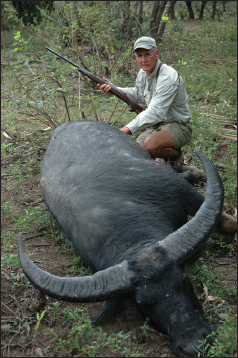
Wayne heart-shot this buffalo with an iron-sighted Savage rifle. This TSX bullet drove through.
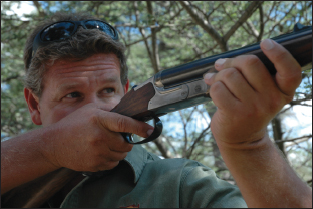
Professional hunter Jamy Traut tries out a .470 Heym double, plain but trim and finely balanced.
Without accuracy, bullet speed and energy accomplish as much as a locomotive jumping the rails.
Over the years, various measures of killing power have been proposed. Naturally, bullet speed, weight, diameter and upset all contribute to the terminal effects of a shot. Some hunters (famously, Elmer Keith) have argued that in the calculation of energy commonly used in ballistics tables, velocity plays too big a part. Alternative formulae put more emphasis on bullet weight. To get more speed is to accept lighter bullets; to get heavier bullets, we concede velocity. Wherever in the weight-velocity spectrum a bullet falls, its construction must match. That is, it must deliver a wide wound channel deep enough to penetrate the vitals. But some shots are taken obliquely, and the vitals may lie behind a shoulder the size of a truck axle. A bullet that delivers explosive upset and adequate penetration through deer ribs at 200 yards will likely fail on a quartering elk at 20.
Given the variable endemic to any field shooting, the all-around hunting bullet is at best a bullet that performs adequately most of the time and perfectly once in a while. Still, shooters have pursued for decades a scale to rank the relative effectiveness of big game loads. Many break down at the extremes of bullet weight and velocity. Among the few with real merit is the H.I.T.S scale. Developed by my colleague Steve Johnson, who works at Hornady, it incorporates all the important factors that make hunting bullets lethal. Here’s how it works:

Wayne killed this caribou with a .300 Ultra Mag. A .243 would have worked every bit as well.
 |
Hornady Index of |
The Hornady Index of Terminal Standards (H.I.T.S.) is intended as a guideline to help hunters compare cartridge and bullet combinations. Beginners and seasoned hunters alike will find these standards useful when sorting through online chat room discussions and gun shop “hype” to make sense of an onslaught of varying information.
The index considers variables such as impact velocity, ballistic coefficient, sectional density and bullet weight. Bullet construction is another important factor in determining the best combination. H.I.T.S. is intended for use with hunting bullets, as match bullets may perform unpredictably on game animals.
Remember, H.I.T.S. is merely a guideline to help you choose the proper bullet/cartridge combination. Be sure to consider impact velocity and bullet construction and select a bullet that is appropriate for your situation. A quick reference guide of Hornady bullets is listed on the right.
The H.I.T.S. rating on Hornady ammunition is based on: 100 yard impact velocities for rifles, muzzleloaders, and shotguns and 50 yard impact velocities for handguns. See how your favorite handload stacks up: Visit www.hornady.com/ballistics to use the online H.I.T.S. calculator.
|
The basic rule of thumb is that a H.I.T.S. rating of 500 or below describes a bullet/cartridge combination best suited for small game animals weighing less than 50 pounds. |
 |
|
A rating of 501 to 900 applies to bullet/cartridge combinations that are applicable for medium sized game, such as deer, antelope, black bear, and caribou, or game weighing 50 to 300 pounds. |
 |
|
A rating of 901 to 1,500 specifies cartridge/bullet combinations well-suited for large and heavy, but not generally considered dangerous game. This includes elk, moose, African plains game, red stag, American bison, and other animals weighing between 300 to 2,000 pounds. |
 |
|
A rating of 1,501 or greater indicates cartridge/bullet combinations that are suitable for dangerous game – game that is content hunting you back. There is no weight rating on this category since animals like African lions may weigh only 400 pounds. |
 |
Hornady Bullet Guide
V-MAX™ and Traditional Varmint - Rapid, explosive expansion. Recommended muzzle velocity range: 2000 to 4000+ fps
InterBond™ - Rapid, controlled expansion with deep penetration. Recommended muzzle velocity range: 2000 to 3600 fps
SST® (Super Shock Tip) - Rapid, controlled expansion with deep penetration. Recommended muzzle velocity range: 2000 to 3300 fps
Traditional Hunting InterLock™ (RN, SP, SP-RP, FP, HP) - Controlled expansion with deep penetration. Recommended muzzle velocity range: 2000 to 3300 fps
FTX™ (available only in factory loaded ammunition) - Rapid, controlled expansion with deep penetration. Recommended muzzle velocity range: Handgun 800 to 2100 fps and Rifle 1800 to 3000 fps.
DGX™ Dangerous Game eXpanding - Deep penetration with highly controlled expansion. Recommended muzzle velocity range: 1700 to 3000+ fps
DGS™ Dangerous Game Solid - Deepest penetration with NO expansion. Recommended muzzle velocity range: 1700 to 3000+fps
FMJ (rifle and handgun) -No expansion, deep penetration. Recommended muzzle velocity range: N/A
XTP™ -Controlled expansion with deep penetration. Recommended muzzle velocity range: 700 to 1500 fps
XTP MAG™ -Controlled expansion with deep penetration at higher velocities than the original XTP. Recommended muzzle velocity range: 1200 to 2300 fps
FPB™ and SST-ML w/ Flex-Tip® technology -Rapid, controlled expansion with deep penetration. Recommended muzzle velocity range: 800 to 2300 fps
A-MAX™ and BTHP Match -Rapid, explosive expansion with limited penetration. Recommended muzzle velocity range: 2000+ fps. These bullets are not recommended for hunting medium and large game.

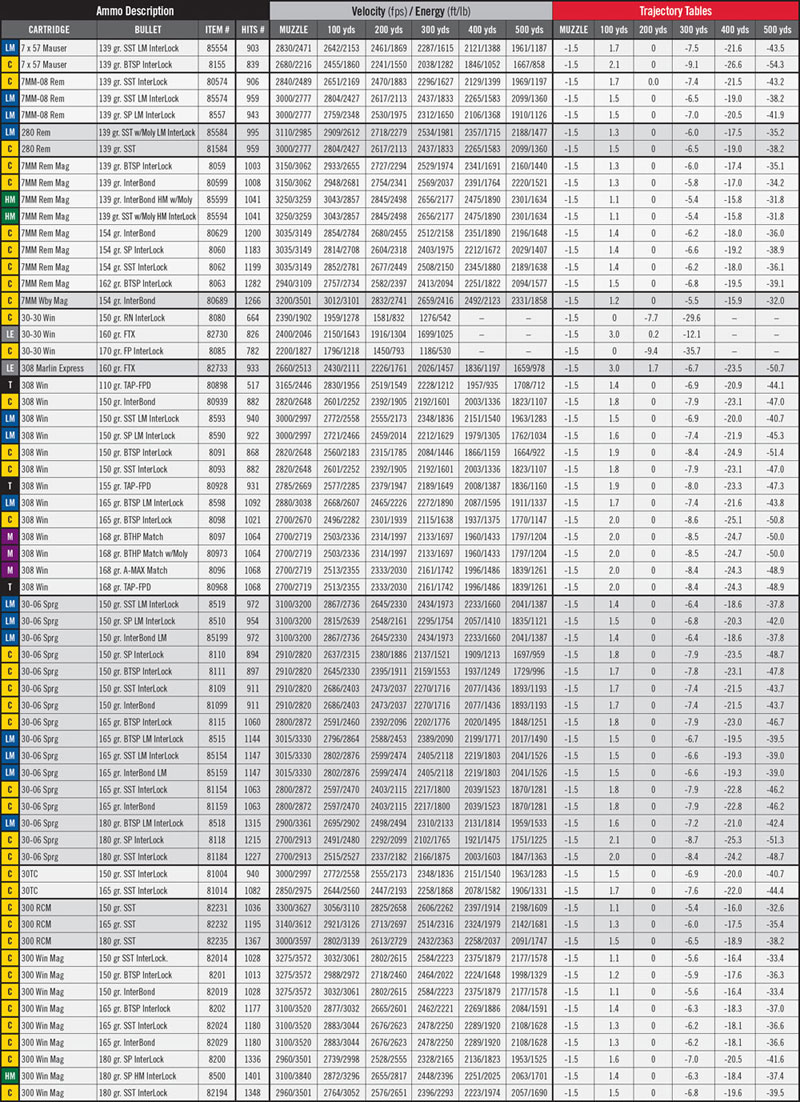
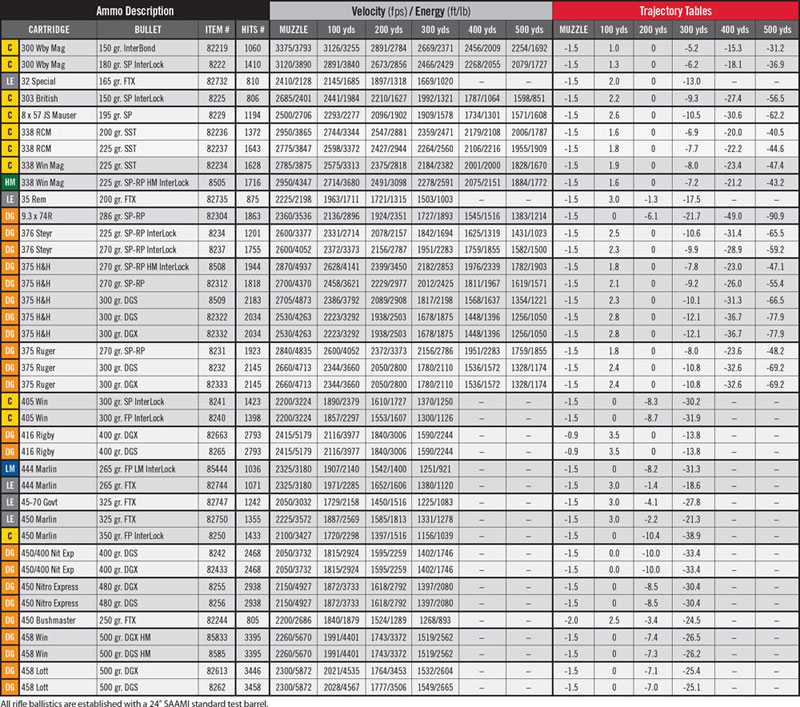
Shotgun Ammunition

Muzzleloader Projectiles

|
Handgun Ammunition |
BALLISTICS |
|
Handgun Ammunition |
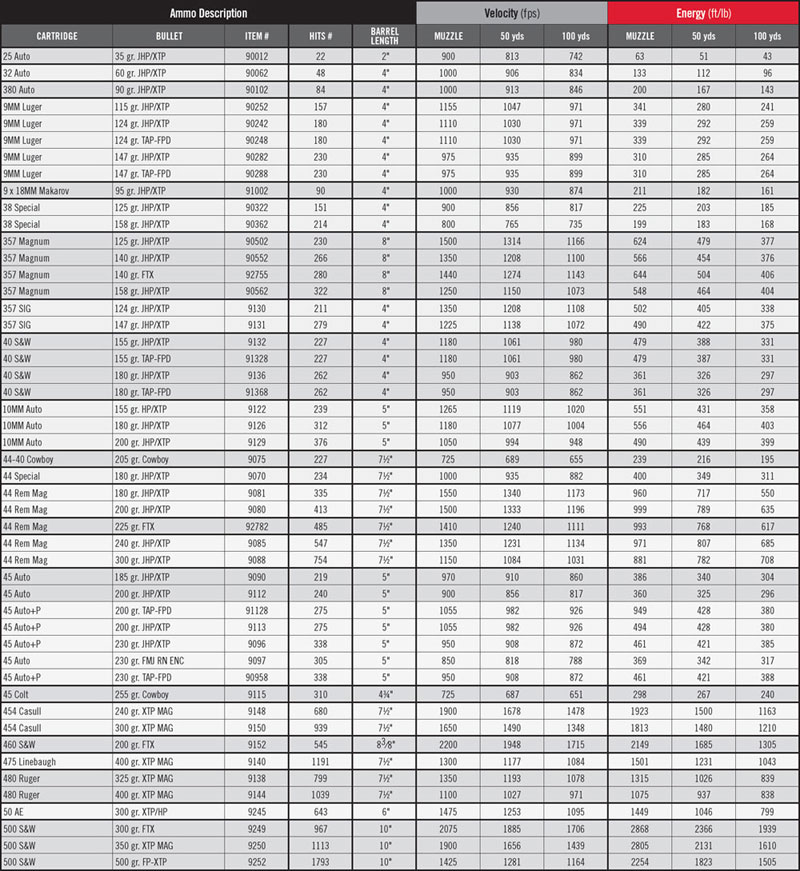

CUSTOM
HANDGUN
F E A T U R E S
1) HIGH PERFORMANCE
HORNADY BULLETS
All Hornady Custom™ pistol ammo is loaded with either the famous Hornady XTP™ (Extreme Terminal Performance) bullet, our fully-encapsulated FMJ or our new FTX bullet. All are supremely accurate, and deliver dependable knockdown power.
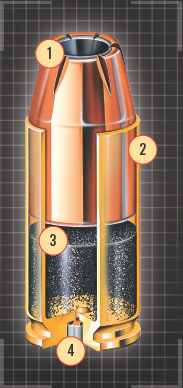
2) SELECT CASES
Hornady produces much of the brass for Hornady Custom™ pistol ammo. All other brass is chosen to ensure it meets our unusually high standards for reliable feeding, corrosion resistance, proper hardness and the ability to withstand maximum chamber pressures.
3) POWDER
Each powder is matched with each load to ensure optimal pressure, velocity, volume, consistency from lot to lot, and accuracy. We use only the highest quality powder, and each new lot is double-checked for consistency.
4) PRIMERS
Like the powder, each primer is carefully matched to its load. All are chosen for their ability to quickly, completely, and reliably ignite the powder charge.
Hornady’s Custom Handgun ammunition starts by meeting the demands of the hunters and shooters who design the cartridges.
Carefully chosen components matching brass, powder, primer and our XTP™, fully encapsulated FMJ or new FTX (Flex Tip eXpanding) bullets all come together to achieve peak accuracy and performance.
Hornady’s Custom™ handgun ammunition is all that you’d expect from Hornady: Hard hitting, deadly, accurate and proven. Try some in your favorite handgun today.

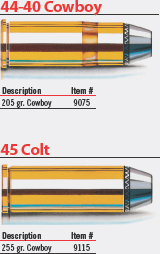 |
Hornady rides tall in the saddle for Cowboy Action Shooting. |
| Cowboy Action Shooters demand total reliability from their ammo – and Hornady delivers! Like all Hornady ammo, our Cowboy Action rounds are engineered to perform flawlessly. Thanks to our swaged bullets, the projectile flattens at the target instead of fragmenting. Our propellants are the cleanest burning, and the diamond knurling means the bullet is lubed the entire length of the bearing surface. It all adds up to the highest quality cowboy ammo on the market. |

Richard Voss took this deer at 186 yards with Hornday’s 460 S&W 200 gr. SST. This was his fourth deer in two days. “All the deer I shot went down like a ton of bricks!” said Richard.
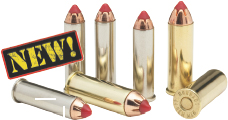

Hornady’s match ammunition is so incredibly accurate, you might think it’s a handload.
We achieve that level of success by hand-picking every component to ensure uniformity. Then the cases, powder, primer and match-grade bullets are loaded to stringent specifications to provide pinpoint accuracy — shot after shot.
Each cartridge is loaded with either Hornady A-MAX™ bullets or our high-performance boat-tail hollow points. Both represent the cutting edge of match bullet technology and accuracy. Stringent quality control ensures that we achieve proper bullet seating, consistent charges and pressures, optimal velocity, and repeatable accuracy.
Loads that are designed, tested and shot in competition by the engineers who design them add up to a cartridge worthy of the world’s best shooters.

MATCH
F E A T U R E S
1) TOP PERFORMING HORNADY
MATCH BULLETS
Hornady match rifle ammunition is loaded with the most accurate, consistent match bullets in the world: our sophisticated boat-tail hollow point match bullets and our technologically advanced A-MAX™ match bullets.

2) SPECIALLY SELECTED CASES
Cases are hand selected based on strict criteria: wall thickness uniformity, internal capacity, case weight and consistent wall concentricity.
3) HAND INSPECTED
The loading process for our match rifle ammo begins with hand selected components and a final hand inspection.
4) POWDER
Powder is matched carefully to each specific load for optimal pressure, velocity and consistent accuracy.
5) PRIMERS
Like the powder, the primers we select are the highest quality available, perfectly matched to the load.
HORNADY
AMMUNITION LINES
Varmint Express™
Varmint Express™ ammunition is loaded with our venerable V-MAX™ bullet, which is specially designed for long-range shooting. From our popular 17-caliber rimfire loads to the 243 Winchester 58 gr. Varmint Express,™ this line will handle anything from plinking to hunting small game.
Custom™ Rifle
With over 70 custom loads to choose from, you’ll find something that meets your needs in Hornady’s Custom™ Rifle Line. With InterBond™, SST®, Interlock, Spire Point or FMJ bullets, you’ll be shooting the finest factory-loaded ammunition on the market today.
LEVERevolution®
LEVERevolution® ammo with Flex Tip™ technology represents the piercing tip of ammunition design.
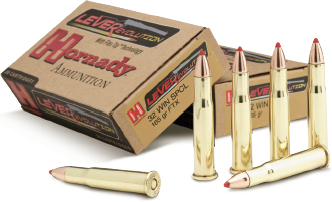
Loaded with Flex Tip™ eXpanding (FTX) bullets, this ammo delivers 40% more energy than traditional loads while remaining safe to use in tubular magazines. And with the introduction of the 357 Mag and 44 Mag, we’re expanding the line to the handgun arena, too.
Custom™ Handgun
Hard hitting and deadly accurate, Hornady’s Custom Handgun ammo is loaded with both our newly introduced FTX™ (Flex Tip™ eXpanding) or time tested XTP™ (Extreme Terminal Performance), or FMJ bullets. Each one delivers superior accuracy and dependable knockdown power.
Light/Heavy Mag™
Hornady’s full line of Light Mag™ and Heavy Mag™ ammunition utilizes cooler-burning powder, revolutionary loading techniques and the most accurate bullets on the market to deliver the highest velocity, hardest hitting factory ammo possible!
Hornady has a product line to meet every shooting need in any environment. From small game to dangerous game– match competitions to muzzleloading, Hornady loads it all!
Dangerous Game Series
The new DGS™ (Dangerous Game Solid) and DGX™ (Dangerous Game eXpanding) bullets are composed of an extremely hard lead alloy core and a copper clad steel jacket that allow Hornady’s new Dangerous Game Series™ ammo to cover every need a dangerous game hunt offers. Extra attention is given to the internal and external ballistics to ensure regulation in doubles and consistent performance no matter how harsh the conditions.
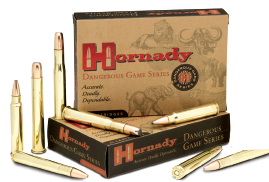
Match
Hornady’s hand-picked cases, powder, primer, and superior match grade bullets are loaded to strict specifications to provide surgical accuracy with every shot. Case in point: the new 6.5 Creedmoor delivers world-class performance in a factory-loaded cartridge that the handloader will have no trouble duplicating. Having the best R&D team in the ammunition industry allows us to deliver the most accurate and consistent match ammo in the world.
TAP FPD™
Specifically designed for personal defense, Hornady’s TAPFPD takes the superior design of our TAP ammo used by elite military groups and law enforcement agencies throughout the world and adds a revolutionary nickel-coated case that extends the reliability, functionality and corrosion resistance of these superbly engineered cartridges.
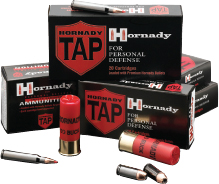
Table of contents
- Title Page
- Dedication
- Copyright
- Acknowledgments
- Foreword
- CONTENTS
- INTRODUCTION
- SECTION I: BALLISTICS IN HISTORY
- SECTION II: THE MUSCLE BEHIND THE SHOT
- SECTION III: BULLETS—THE INSIDE STORY
- SECTION IV: SPEED, ENERGY, AND ARC
- SECTION V : PUTTING BALLISTICS TO WORK
- SECTION VI: FOR LONGER REACH
- BALLISTICS TABLES FOR MODERN SPORTING RIFLES
- GLOSSARY